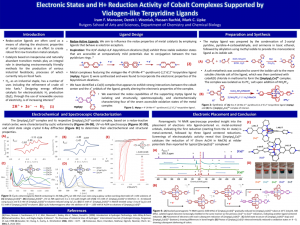Mansoor, Iram F.: Electronic States and H+ Reduction Activity of Cobalt Complexes Supported by Viologen-like Terpyridine Ligands
Title: Electronic States and H+ Reduction Activity of Cobalt Complexes Supported by Viologen-like Terpyridine Ligands
Name: Iram F. Mansoor
Major: Chemistry
School affiliation: School of Arts and Sciences
Programs: Honors Senior Research for credit
Other contributors: Derek I. Wozniak, Hassan Rachid, Mark C. Lipke
Abstract: The use of redox-active ligands to alter the electronic properties of metal complexes has garnered increasing attention as an effective approach to designing catalysts using first row transition metals (e.g. Co). However, little attention has been given to ligands incorporating the redox activity of N,N′-dialkyl-4,4′-bipyridinium (viologen) dications, despite substituted pyridines featuring prominently in other redox-active ligands (e.g. 2,6-diiminopyridine). Thus, the viologen-like ligand 4′-(N-Me-4′′′-pyridinium)-2,2′:6′,2′′-terpyridine (mptpy) was used to prepare [(mptpy)2Co]4+, which was characterized spectroscopically (UV-vis, NMR, and EPR), structurally (single crystal X-ray diffraction), and electrochemically (cyclic voltammetry and chemical reduction). Notably, seven redox states are accessible (5+, 4+, 3+, 2+, 1+, 0, -1) – a drastic difference from the four states available to most [(terpy)Co]2+ complexes. The 0 to 4+ states of [(mptpy)2Co]n+ were characterized in detail. Evans method magnetic measurements and paramagnetic 1H NMR spectroscopy provided insight into the placement of electrons into ligand vs. metal orbitals, indicating the first reduction (starting from the 4+ state) is metal centered, followed by three ligand centered reductions. UV-vis-NIR measurements confirmed that these cobalt complexes have electronic structures that differ significantly from those of a control complex [(mptpy)2Zn]n+ (n = 0, 2, 4) with a redox-inactive metal center. Screenings of electrocatalytic activity reveal that [(mptpy)2Co]4+ catalyzes the reduction of H+ (from AcOH in MeCN) at milder potentials than reported for typical [(terpy)Co]2+ complexes.
